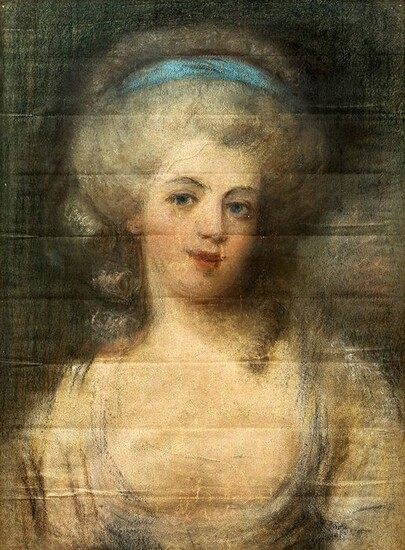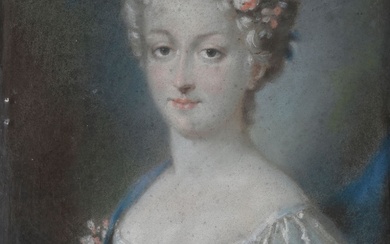Nello stile di Rosalba Carriera (Venezia, 1673 - 1757) - Ritratto di Dama
\Artist: Nello stile di Rosalba Carriera (Venezia, 1673 - 1757)
Technique: Pastel\Signature: Not signed\Dimensions: 86_10_72_cm
In the style of Rosalba Carriera (Venice, 1673 – 1757) Portrait of a lady Pastel on paper, 58 x 43 cm. Frame size: approx. 76 x 61 x 5 cm. Notes: With certificate of warranty and lawful origin. Complete with frame. “… The quality of the drafts and the chromatic freshness lead to support the attribution of the work to an artist who looks at the famous Rosalba Carriera, a famous portraitist of the Rococo age whose works were collected throughout Europe. Refined interpreter of the ideals of eighteenth-century worldly society, the painter distinguished herself in pastel painting using a very personal technique, obtaining effects of silky brightness with a peculiar atmospheric character. A few years after the death of one of the most cherished female figures in the history of Italian art: Artemisia Gentileschi; the art of painting did not seem to want to see a hand of the fair sex move away from it and in 1673 Rosalba Carriera was born in Venice. From a fairly wealthy family, Rosalba was able to travel a lot, especially to Paris, where as a guest of Pierre Crozat she entered the Academy of the French capital and met Antoine Watteau, with whom she had numerous and fruitful artistic exchanges. Another important point of reference in the life of Rosalba Carriera was Antonio Maria Zanetti the Elder, an amateur engraver and art collector, especially of Rembrandt's engravings and drawings, which she had had the opportunity to purchase during a trip to Rotterdam in the 1720s. ; thanks to him Rosalba would meet the Dutch master of the seventeenth century, focal point and inspiration of the artists of the Venice of the eighteenth century. During her stay in Paris, Rosalba became very close to the pastel technique, of which she would become one of the greatest interpreters in the history of European art. To really understand Rosalba's art, it is interesting to talk briefly about the pastel technique: it is made up of pigments mixed with water and agglutinating substances; it needs a rough or made such surface to take at its best, moreover, it gives the possibility to recreate nuanced effects of considerable intensity. During the 15th and 16th centuries it was used alone as a redefinition technique, except by Hans Holbein; subsequently it became an artistic technique in its own right of which the main interpreter was Rosalba Carriera, although the figure of Jean-Etienne Liotard should not be forgotten. The pastel technique lends itself very well to portraiture, to which it manages to give touches of greater vivacity and particular nuances. One of the most recurrent colours in pastel is a bright blue, almost irreproducible in painting and which represents the stylistic signature of a work created with this technique. Here we can see how pastel is able to make the faces of portraits brighter and how it liven up even the most fixed representations, such as portraits. The colours are bright and to be noted is the ubiquitous touch of blue. There is no lack of artistic virtuosity: an example of this is the embroidered foulard or the splendid curls, drawn almost hair by hair. The figure of this girl appears splendid and angelic, after many centuries it is as if there was a return to the figure of the ideal and almost unattainable woman. The whole portrait is executed in shades of fundamental blue, which ends up dispersing in touches of light reflected by the whiteness of the skin. Rosalba's portraits are numerous and all beautiful and noteworthy, but in order not to dwell too long it will be useful to make only one last note about her self-portraits. Rosalba is impassive about herself, good as she is at returning the psychology and feelings of the people portrayed, she is equally psychologically interested in herself. Rosalba is not afraid of seeing herself grow old, but her eyes show a regret, a missed love or a missed opportunity; she spent all her life to be an artist and to study (she knew English and at the time it was not a trivial matter for a woman) , only to feel lost in the void. Rosalba's melancholy eyes seem to convey this, but her attitude remains fierce and proud, she seems aware of being unique, of being the true queen of her art. Regarding the state of preservation, the pastel painting shows the imprint of various folds of the sheet and some slight stains. Size: 58 x 43 cm. The painting comes with frame ( size: approx. 76 x 61 x 5 cm) . Origin: private collection. We guarantee accurate packaging with outer wooden crate and inner bubble wrap / cardboard / polystyrene (packaging cost: approximately €100. 00) and tracked shipping (€100. 00 Italy) . For export, the work is subject to a new request for Certificate of Free Circulation (European Community) or Export Certificate (Extra-EU Transport) at the export office (Soprintendenza del Territorio) with additional times and costs (€500/€1000, all inclusive: shipping, packaging, and export documents) .
View it on
Sale price
Estimate
Time, Location
Auction House
\Artist: Nello stile di Rosalba Carriera (Venezia, 1673 - 1757)
Technique: Pastel\Signature: Not signed\Dimensions: 86_10_72_cm
In the style of Rosalba Carriera (Venice, 1673 – 1757) Portrait of a lady Pastel on paper, 58 x 43 cm. Frame size: approx. 76 x 61 x 5 cm. Notes: With certificate of warranty and lawful origin. Complete with frame. “… The quality of the drafts and the chromatic freshness lead to support the attribution of the work to an artist who looks at the famous Rosalba Carriera, a famous portraitist of the Rococo age whose works were collected throughout Europe. Refined interpreter of the ideals of eighteenth-century worldly society, the painter distinguished herself in pastel painting using a very personal technique, obtaining effects of silky brightness with a peculiar atmospheric character. A few years after the death of one of the most cherished female figures in the history of Italian art: Artemisia Gentileschi; the art of painting did not seem to want to see a hand of the fair sex move away from it and in 1673 Rosalba Carriera was born in Venice. From a fairly wealthy family, Rosalba was able to travel a lot, especially to Paris, where as a guest of Pierre Crozat she entered the Academy of the French capital and met Antoine Watteau, with whom she had numerous and fruitful artistic exchanges. Another important point of reference in the life of Rosalba Carriera was Antonio Maria Zanetti the Elder, an amateur engraver and art collector, especially of Rembrandt's engravings and drawings, which she had had the opportunity to purchase during a trip to Rotterdam in the 1720s. ; thanks to him Rosalba would meet the Dutch master of the seventeenth century, focal point and inspiration of the artists of the Venice of the eighteenth century. During her stay in Paris, Rosalba became very close to the pastel technique, of which she would become one of the greatest interpreters in the history of European art. To really understand Rosalba's art, it is interesting to talk briefly about the pastel technique: it is made up of pigments mixed with water and agglutinating substances; it needs a rough or made such surface to take at its best, moreover, it gives the possibility to recreate nuanced effects of considerable intensity. During the 15th and 16th centuries it was used alone as a redefinition technique, except by Hans Holbein; subsequently it became an artistic technique in its own right of which the main interpreter was Rosalba Carriera, although the figure of Jean-Etienne Liotard should not be forgotten. The pastel technique lends itself very well to portraiture, to which it manages to give touches of greater vivacity and particular nuances. One of the most recurrent colours in pastel is a bright blue, almost irreproducible in painting and which represents the stylistic signature of a work created with this technique. Here we can see how pastel is able to make the faces of portraits brighter and how it liven up even the most fixed representations, such as portraits. The colours are bright and to be noted is the ubiquitous touch of blue. There is no lack of artistic virtuosity: an example of this is the embroidered foulard or the splendid curls, drawn almost hair by hair. The figure of this girl appears splendid and angelic, after many centuries it is as if there was a return to the figure of the ideal and almost unattainable woman. The whole portrait is executed in shades of fundamental blue, which ends up dispersing in touches of light reflected by the whiteness of the skin. Rosalba's portraits are numerous and all beautiful and noteworthy, but in order not to dwell too long it will be useful to make only one last note about her self-portraits. Rosalba is impassive about herself, good as she is at returning the psychology and feelings of the people portrayed, she is equally psychologically interested in herself. Rosalba is not afraid of seeing herself grow old, but her eyes show a regret, a missed love or a missed opportunity; she spent all her life to be an artist and to study (she knew English and at the time it was not a trivial matter for a woman) , only to feel lost in the void. Rosalba's melancholy eyes seem to convey this, but her attitude remains fierce and proud, she seems aware of being unique, of being the true queen of her art. Regarding the state of preservation, the pastel painting shows the imprint of various folds of the sheet and some slight stains. Size: 58 x 43 cm. The painting comes with frame ( size: approx. 76 x 61 x 5 cm) . Origin: private collection. We guarantee accurate packaging with outer wooden crate and inner bubble wrap / cardboard / polystyrene (packaging cost: approximately €100. 00) and tracked shipping (€100. 00 Italy) . For export, the work is subject to a new request for Certificate of Free Circulation (European Community) or Export Certificate (Extra-EU Transport) at the export office (Soprintendenza del Territorio) with additional times and costs (€500/€1000, all inclusive: shipping, packaging, and export documents) .




